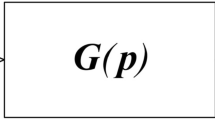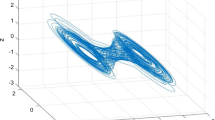Abstract
A new hybrid scheme of model order reduction (MOR) technique is developed for the simplification and control design of linear large-scale dynamical systems. MOR deals with a high-dimensional problem in a compact representation and plays an important role in fields where complicated simulation studies are still problematic in terms of simulation time. This paper proposes a strategy to derive a reduced order model (ROM) using Balanced Singular Perturbation Approximation. This way reduces the higher order system into a reduced order model. The proposed method guarantees the preservation of all essential parameters of the original model in the reduced system. The results of the proposed method are compared with the results of the reduced order model by previously published work. Further, this ROM has been used for the design of a compensator for the large-scale original plant by using the proposed method. The compensator obtained by using the reduced model gives the approximately same time domain specification as the compensator obtained by using a large-scale original system, and the design of the compensator by using the reduced model is comparatively easier. The performance of the higher and lower-order controllers is also analysed with numerical examples in terms of time response characteristics and time domain specifications and performance indices.











Similar content being viewed by others
Data Availability
My manuscript has no associated data.
References
V.M. Adamjan, D.Z. Arov, M.G. Krein, Analytic properties of schmidt pairs for a hankel operator and the generalized schur-takagi problem. Math USSR Sb. 15(1), 31 (1971)
A.C. Antoulas, Approximation of large-scale dynamical systems: An overview. IFAC Proc. 37(11), 19–28 (2004). https://doi.org/10.1016/S1474-6670(17)31584-7
A.C. Antoulas, Approximation of large-scale dynamical systems (Approximation of Large-Scale Dynamical Systems. Society for Industrial and Applied Mathematics, Philadelphia, PA, 2005), p.479
A.C. Antoulas, D.C. Sorensen, Y. Zhou, On the decay rate of Hankel singular values and related issues. Syst. Control. Lett. 46(5), 323–342 (2002). https://doi.org/10.1016/S0167-6911(02)00147-0
D. Boley, B. N. Datta, Numerical methods for linear control systems. In: Systems and Control in the Twenty-First Century. Birkhäuser, Boston, MA, pp. 51–74 (1997)
A.M. Bruaset, A.M. Bruaset, Krylov subspace methods. In: A Survey of Preconditioned Iterative Methods. Routledge, Boca Raton (2019)
A. Castagnotto, M. Cruz Varona, L. Jeschek, B. Lohmann, MOR: analysis and reduction of large-scale dynamic systems in MATLAB. At-Automatisierungstechnik (2017)
T.C. Chen, C.Y. Chang, K.W. Han, Model reduction using the stability-equation method and the continued-fraction method. Int. J. Control. 32(1), 81–94 (1980)
D. F. Enns, Model reduction with balanced realizations: an error bound and a frequency weighted generalization. In: Proceedings of the IEEE Conference on Decision and Control, pp. 127–132 (1984)
K.V. Fernando, H. Nicholson, Singular perturbational model reduction in the frequency domain. IEEE Trans. Automat. Contr. 27(4), 969–970 (1982)
K.V. Fernando, H. Nicholson, Singular perturbational approximations for discrete-time balanced systems. IEEE Trans. Automat. Contr. 28(2), 240–242 (1983)
M.J. Goldman, W.J. Porras, C.T. Leondes, Multivariable systems reduction via cauer forms. Int. J. Control. 34(4), 623–650 (1982)
S. Gugercin, An iterative SVD-Krylov based method for model reduction of large-scale dynamical systems. Linear Algebra Appl. 428(9), 1964–1986 (2008)
C. Guiver, The generalised singular perturbation approximation for bounded real and positive real control systems. Math. Control. Relat. Fields. 9(2), 313–350 (2019)
P. Gutman, C.F. Mannerfelt, P. Molander, Contributions to the Model Reduction Problem. IEEE Trans. Automat. Contr. 27(2), 454–455 (1982)
C. Huang, K. Zhang, X. Dai, W. Tang, A modified balanced truncation method and its application to model reduction of power system. In: IEEE Power and Energy Society General Meeting, pp. 1–5 (2013)
Y.S. Hung, K. Glover, Optimal Hankel-norm approximation of stable systems with first-order stable weighting functions. Syst. Control. Lett. 7(3), 165–172 (1986)
M.F. Hutton, B. Friedland, Routh approximations for reducing order of linear, time-invariant systems. IEEE Trans. Automat. Contr. 20(3), 329–337 (1975)
M. Imran, A. Ghafoor, V. Sreeram, A frequency weighted model order reduction technique and error bounds. Automatica 50(12), 3304–3309 (2014)
P.V. Kokotovic, R.E. O’Malley, P. Sannuti, Singular perturbations and order reduction in control theory—an overview. Automatica 12(2), 123–132 (1976)
R. Komarasamy, N. Albhonso, G. Gurusamy, Order reduction of linear systems with an improved pole clustering. J. Vib. Control. 18(12), 1876–1885 (2012)
G.A. Latham, B.D.O. Anderson, Frequency-weighted optimal Hankel-norm approximation of stable transfer functions. Syst. Control. Lett. 5(4), 229–236 (1985)
Y. Liu, B.D.O. Anderson, Singular perturbation approximation of balanced systems. Int. J. Control. 50(4), 1379–1405 (1989)
J. Mohammadpour, K.M. Grigoriadis, Efficient modeling and control of large-scale systems. In: Efficient Modeling and Control of Large-Scale Systems. Springer Science & Business Media (2010)
B.C. Moore, Principal component analysis in linear systems: controllability, observability, and model reduction. IEEE Trans. Automat. Contr. 26(1), 17–32 (1981)
A. Narwal, R. Prasad, Optimization of LTI systems using modified clustering algorithm. IETE Tech. Rev. (Institution Electron Telecommun Eng India). 34(2), 201–213 (2017)
J. Pal, Reduced order models for control studies. Ph.D. Thesis, University of Roorkee, Roorkee, India (1980)
J. Pal, Stable reduced-order padé approximants using the routh-hurwitz array. Electron. Lett. 15(8), 225–226 (1979)
G. Parmar, S. Mukherjee, R. Prasad, System reduction using eigen spectrum analysis and Padé approximation technique. Int J Comput Math. (2007)
G. Parmar, S. Mukherjee, R. Prasad, System reduction using factor division algorithm and eigen spectrum analysis. Appl. Math. Model. 31(11), 2542–2552 (2007)
A.K. Prajapati, R. Prasad, Order reduction of linear dynamic systems with an improved routh stability method. In: 2018 International Conference on Control, Power, Communication and Computing Technologies, ICCPCCT 2018, pp. 362–367 (2018)
A.K. Prajapati, R. Prasad, A new model reduction method for the linear dynamic systems and its application for the design of compensator. Circuits Syst Signal Process, pp. 1–21 (2019)
A.K. Prajapati, R. Prasad, Order reduction in linear dynamical systems by using improved balanced realization technique. Circuits Syst. Signal Process. 38(11), 5289–5303 (2019). https://doi.org/10.1007/s00034-019-01109-x
A.K. Prajapati, R. Prasad, Reduced-order modelling of LTI systems by using Routh approximation and factor division methods. Circuits Syst. Signal Process. 38(7), 3340–3355 (2019)
A.K. Prajapati, R. Prasad, Model order reduction by using the balanced truncation and factor division methods. IETE J. Res. 65(6), 827–842 (2019)
A.K. Prajapati, R. Prasad, J. Pal, Contribution of time moments and markov parameters in reduced order modeling. In: 2018 3rd International Conference for Convergence in Technology, I2CT 2018. IEEE, pp. 1–7 (2018)
A.K. Prajapati, V.G.D. Rayudu, A. Sikander, R. Prasad, A New Technique for the reduced-order modelling of linear dynamic systems and design of controller. Circuits Syst. Signal Process. 39(10), 4849–4867 (2020). https://doi.org/10.1007/s00034-020-01412-y
M.G. Safonov, R.Y. Chiang, A Schur method for balanced-truncation model reduction. IEEE Trans. Automat. Contr. 34(7), 729–733 (1989)
D.K. Sambariya, G. Arvind, Reduced order modelling of SMIB power system using stability equation method and firefly algorithm. In: 2016 IEEE 6th International Conference on Power Systems, ICPS 2016, pp. 1–6 (2016)
D. Sambariya, G. Arvind, High order diminution of LTI system using stability equation method. Br. J. Math. Comput. Sci. 13(5), 1–15 (2016)
D.K. Sambariya, A.K. Sharma, T. Gupta, Order reduction of air core transformer using continued fraction. J. Eng. Sci. Technol. 14(1), 253–264 (2019)
P. Saraswat, G. Parmar, Model order reduction of transformer linear section model using Simulated Annealing. In: 2015 Communication, Control and Intelligent Systems (CCIS), IEEE, (pp. 272–276) (2015)
C.H. Seshukumar, B. Dasu, M.S. Kumar, A hybrid reduction technique for transformer linear section model. Int J Eng Res Technol. 2(11), 3494–3498 (2013)
Y. Shamash, Stable reduced-order models using pade-type approximations. IEEE Trans Automat Contr. 19(5), 615–616 (1974)
A. Sikander, R. Prasad, Linear time-invariant system reduction using a mixed methods approach. Appl Math Model. 39(16), 4848–4858 (2015)
A. Sikander, R. Prasad, Soft computing approach for model order reduction of linear time invariant systems. Circuits Syst Signal Process. 34(11), 3471–3487 (2015)
A. Sikander, P. Rajendra, A new technique for reduced-order modelling of linear time-invariant system. IETE J. Res. 63(3), 316–324 (2017)
A. Sikander, P. Thakur, Reduced order modelling of linear time-invariant system using modified cuckoo search algorithm. Soft Comput. 22(10), 3449–3459 (2018)
A. Sikander, P. Thakur, I. Uniyal, Hybrid method of reduced order modelling for LTI system using evolutionary algorithm. In: Proceedings on 2016 2nd International Conference on Next Generation Computing Technologies, NGCT 2016. IEEE, pp. 84–88 (2017)
A. Sikander, P. Thakur, R.C. Bansal, S. Rajasekar, A novel technique to design cuckoo search based FOPID controller for AVR in power systems. Comput. Electr. Eng. 70, 261–274 (2018)
J. Singh, C.B. Vishwakarma, K. Chatterjee, SISO method using improved modified pole clustering and genetic algorithm. In: International Conference on Energy Economics and Environment—1st IEEE Uttar Pradesh Section Conference, UPCON-ICEEE 2015. IEEE, pp. 1–4 (2015)
M. Srinivsan, A. Krishnan, Transformer linear section model order reduction with an improved pole clustering. Eur. J. Sci. Res. 44(4), 541–549 (2010)
S.K. Suman, Reduction of large-scale dynamical systems by extended balanced singular perturbation approximation. Int. .J Math. Eng. Manag. Sci. 5(5), 939–956 (2020)
S.K. Suman, A. Kumar, Investigation and Implementation of model order reduction technique for large scale dynamical systems. Arch. Comput. Methods Eng., pp. 1–23 (2022). https://doi.org/10.1007/s11831-021-09690-8
S.K. Suman, A. Kumar, Investigation and reduction of large-scale dynamical systems. WSEAS Trans. Syst. 18, 175–180 (2019)
S.K. Suman, A. Kumar, Higher-order reduction of linear system and design of controller. Sci J King Faisal Univ. 2020(3), 1–16 (2020)
S.K. Suman, A. Kumar, Model reduction of power system by modified balanced truncation method. Univ. J. Control. Autom. 8(3), 41–52 (2020)
S.K. Suman, A. Kumar, Linear system of order reduction using a modified balanced truncation method. Circuits Syst. Signal Process. 40(6), 2741–2762 (2021)
C.B. Vishwakarma, Order reduction using modified pole clustering and Pade approximations. World Acad. Sci. Eng. Technol. 56, 787–791 (2011)
C.B. Vishwakarma, R. Prasad, Clustering method for reducing order of linear system using pade approximation. IETE J. Res. 54(5), 326–330 (2009)
C.B. Vishwakarma, R. Prasad, MIMO system reduction using modified pole clustering and genetic algorithm. Model. Simul. Eng. 2009, 1–5 (2009)
J.-C. Yoccoz, Continued fraction algorithms for interval exchange maps: an introduction. In: Frontiers in Number Theory, Physics, and Geometry I. Proceedings of the Spring School at Les Houches, France, pp. 401–435 (2007)
K. Zhou, G. Salomon, E. Wu, Balanced realization and model reduction for unstable systems. Int. J. Robust. Nonlinear Control. 9(3), 183–198 (1999)
Funding
No third party or organization provided funds for this research so far.
Author information
Authors and Affiliations
Corresponding author
Ethics declarations
Conflict of interest
The authors declare no conflict of interest regarding this research work.
Additional information
Publisher's Note
Springer Nature remains neutral with regard to jurisdictional claims in published maps and institutional affiliations.
Rights and permissions
Springer Nature or its licensor (e.g. a society or other partner) holds exclusive rights to this article under a publishing agreement with the author(s) or other rightsholder(s); author self-archiving of the accepted manuscript version of this article is solely governed by the terms of such publishing agreement and applicable law.
About this article
Cite this article
Suman, S.K. A New Scheme for the Approximation of Linear Dynamical Systems and Its Application to Controller Design. Circuits Syst Signal Process 43, 766–794 (2024). https://doi.org/10.1007/s00034-023-02503-2
Received:
Revised:
Accepted:
Published:
Issue Date:
DOI: https://doi.org/10.1007/s00034-023-02503-2




